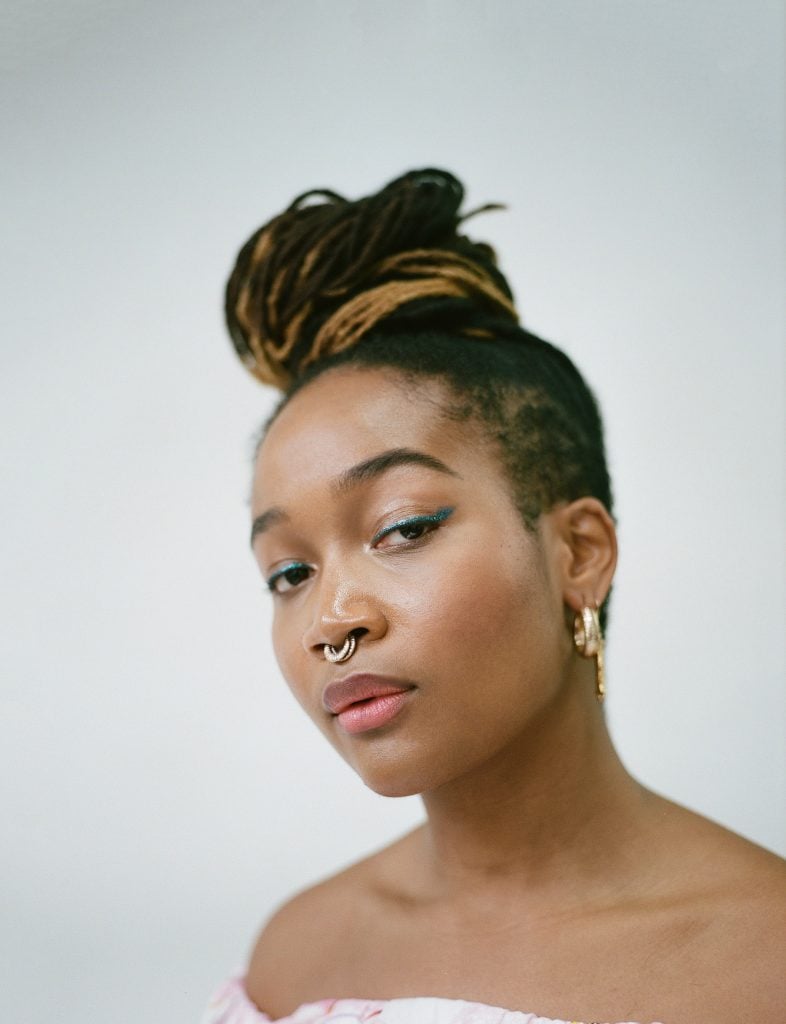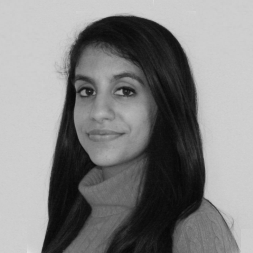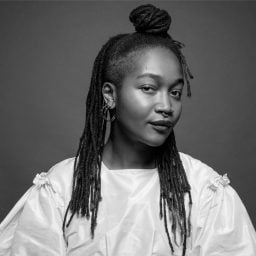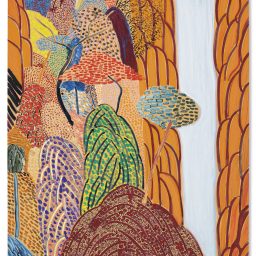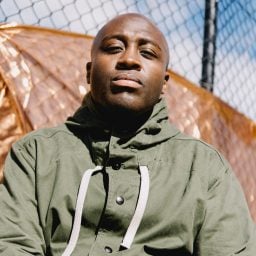There’s no one quite like Kimberly Drew. A writer, curator, social media expert, and fashion girl who began her career as social media manager for the Metropolitan Museum of Art, Drew has carved out a space as a multi-hyphenate tastemaker and advocate, tapping her many talents to innovate within the art world’s institutional spaces in the hopes that her work will help transform them into more fair and equitable places that are appropriately representative of diverse creators and their histories.
Known in particular for amplifying the work of Black creators, Drew is a leading voice at the nexus of art and activism, which she wrote about in her recently released young-adult book, This Is What I Know About Art. At the end of this year, she will release her second book, Black Futures, a compendium of essays, artworks, recipes, poems, and more by artists, writers, and activists that collectively examines “what it means to be Black and alive” in 2020.
Artnet News recently selected Drew as one of its New Innovators, 51 professionals pushing the art industry forward. The New Innovators list leads the Fall 2020 Artnet Intelligence Report.
The conversation with Drew below, conducted by Artnet News’s Noor Brara, is an expansion of Drew’s entry on the list, in which she discusses in further detail her experience of navigating the art world as a young Black woman, what she feels about where the industry stands today, and her thoughts on where we go from here.
What drew you to visual art specifically? Why is art important to you?
Oh my god, it’s so important. I was really fortunate because I was raised in a family that really valued creativity. My family in general was like, “Okay. If you want to draw, you should draw. If you want to play basketball, do that. Whatever your passion is, that should be the purpose of your life.” Art was always an option in the same way that everything else was, and I can’t say there was a particular time when I wasn’t interested in art, or on my own decided this is what I want to do.
The professional side of it came about once I was a little more advanced in my education and could really assess from that vantage point what my options were. But I was always into art—I talk about astrology all the time, and my birth chart says, “This person will be involved in art in some way.” So there’s a sense of a divine purpose. And it’s funny because my aunts—my dad’s two elder sisters, one is an artist and the other loves art and took us to museums a lot as kids—said to me when I came home with an art history degree, “Oh, you thought you chose this?” [laughs]
How did you decide to focus on the work that you do? Between writing, curating, social media and other collaborative projects, it whirls between nearly all art professions, but I suppose it’s first and foremost rooted in trying to innovate and realize an art world that’s more fair and equitable.
I would say it’s been a very iterative process. I started, like many, as an intern first. I was an intern at the Studio Museum in Harlem and I was also a museum educator at the Smith College Museum of Art when I was a student there. Because of the opaque way that the art world is set up, it’s kind of hard as a marginalized person who wasn’t growing up as a child of parents who were collectors or curators. There is a way-finding that I think some folks end up doing, and I was definitely not in that group of folks. It was very much a process of trial and error, especially in the beginning.
And in many ways you caught people’s attention attention for asking questions aloud on social media along the way. What was your experience like with using Instagram to share your thoughts and questions about art and the art world?
In the very beginning, I was surprised, I guess? I say that with hesitation because I’m not sure if it was my surprise or the surprise of others that I was encountering in the field. But rolling in, as a kid… you know, I didn’t look like everyone in my intern class. Coming into the field, I thought, “Okay, if I can make it, anybody can make it!” I feel really different differently now. I think having had nearly a decade of experience, I understand that a lot of my success is due to my hard work. But in the beginning, I was like, “Anyone can do it! It’s so easy! You just show up!” [laughs] Because all you have to go on is optimism. I would spend my weekends in Chelsea going and visiting galleries because they were free, and at that time I was making very little money, so it felt like the most accessible way to share with people. That’s really where and how I found my voice on Instagram. As cheesy as it sounds, it was more about saying, “You can do this, too, in this way.” I thought very much, and still believe now, that most of the time people just need help figuring out where to go and what to see. So Instagram is like a mini-Rosetta Stone for so many people who want to be involved, but have no idea where to start.
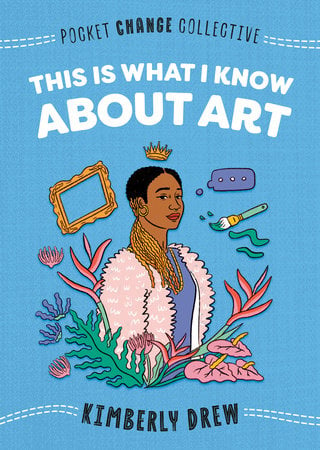
Photo courtesy Pocket Change Collective.
Earlier this year, you released your first young-adult book, This Is What I Know About Art, about the connection between art and activism. Why did you want to write about that?
I realized that for those who are interested in participating in the art world on an institutional level, their education needs to start earlier. For me, it took such a long while to figure out that I wanted to be studying art and that art was a possibility for me, and so I wanted to write a young-adult book specifically to light that fire for those who might be considering art in some capacity, and maybe need a little bit of hand-holding to see themselves realized as art professionals.
How are you feeling about the book now and its place in the culture? I’m curious to know what people are saying about it since the subject matter ended up being pretty instructive for us all this year.
Yeah, it came out in the middle of such a wild moment. Launch day was Blackout Tuesday, when everyone was posting those black squares. I’d written it in such a different time. It came out in a moment when many were pausing to reflect. In some ways, as a person who’s interested in purveying art and creativity, that first week was very touch-and-go in terms of how to initiate dialogue, but for me, it’s been really affirming and in many ways instructive to talk to young people directly. In the middle of uprisings and moments of being so downtrodden, being able to hop on Zoom with eight-year-olds is truly such a light. Being able to talk with young people who are very much the future about some of the things that they’re trying make sense of, and arriving as an author in the youth space, I was able to tap into a different way of seeing. That was the most instructive part of the process because people have been giving feedback, and I’ve been getting pictures of my friends’ babies holding the book and that’s been really incredible, especially because so many of them are incredible Black women curators who are also amazing mothers. And these kids have those moms and somehow they have room for my world, too, which is really such an honor.
Another nexus you’ve successfully tapped into—perhaps more than anyone else in the art world—is that between art and fashion. How do you find ways to unite those two worlds in your work?
For me, it’s about finding the natural connections between the two. For example, it’s amazing to see Loewe partnering with Anthea Hamilton this season, whose work I saw at Tate. Or even Maty Biayenda, who did the backdrop for the Kenneth Ize show. There are a lot of natural, beautiful pairings, and I’m just privileged to be in a moment when those are happening and I can partner with these brands in interesting ways and start conversations with these artists about this work, or recommend artists to brands or help them build connections with some of the artists in my network. I’m inspired by artists like Devin Morris or Eric Mack who have continued to be engaged with textiles and specifically fashion as a medium, so it’s nice to see those barriers not necessarily lowering, but shifting in a way that’s hopefully productive.
Definitely. Are you ever skeptical of these collaborations, when big brands reach out to artists for help?
I think that that question is hard… especially when you’re talking about a brand like Loewe that has an art fund and consistently supports artists and their projects. I think it’s amazing to see those connections happen and I think I’m genuinely hopeful about what they can look like. I think all too often we don’t always think of artists as running their own businesses, and when you think about it in that way, you begin to look at it a little differently. Of course I hope that the intentions are good, and I think it’s important for us to hold especially the legacy brands to that standard. But I’m also like, “Yes!” It’s great to see people being able to engage in these kinds of partnerships in ways that are hopefully beneficial for those who are raising children and paying taxes and all these other things. So yes, it’s something I hold dear to my heart, but of course I always hope that these collaborations are the most fruitful things possible, and they generate good conversation and longstanding engagement and so I’m shipping that, as a hope.
If you could change any one thing about the art world, what would it be?
I guess I would even just change the name. I think that there is a classification that is implied by calling it the art world as a field, which is so confusing and it’s so much more porous than that, so I guess my biggest desire for change is that we understand how much more abundant the ways in which we think about creativity can be. Because I think everyone means a certain thing when they say “the art world.” And I think that bothers me. So I think I’d like either more dynamism or more specificity.
What do you think the art world will look like in 2025?
I hope very dearly that smaller institutions will receive the support that they deserve. I think that’s the biggest priority as we look ahead to 2025. And as we exit 2020, there are so many smaller museums and family-owned museums that are really suffering because of the pandemic and I hope that by 2025 they will be fully recovered and hopefully in the best position they are able to be in to support their respective communities.
And what are you working on now?
I’m doing a lot of writing. I’m also just really taking time to assess what I want to be doing. This pandemic has pulled so many of us down, and I’m trying my very best to take advantage of the time to reconsider because for so much of my career, I’ve been working so hard for myself and for others and I think right now I have a little bit more of a pause to assess the good of it all. The work still gets done, and there are ideas that I want to put forth, but more than anything, I’ve just been prioritizing going a little bit slower.
I have my second book, Black Futures, coming out in December, too, so that helps with not feeling like I have to run at full sprint. Jenna [Wortham, Drew’s co-editor] and I have been trying to map out what the release should look like. We’ve been trying to set up ways to bolster that project to make sure that it has tremendous success. We got the first round of copies the other day, and it’s honestly so good [laughs]. That’s weird to say, but I’m so proud of it, so whatever energy I have right now has kind of gone into trying to set up the best situation for it to exist in the world.
